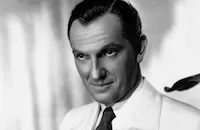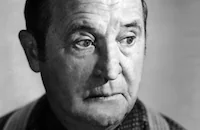Idiot's Delight

Brief Synopsis
Cast & Crew
Clarence Brown
Norma Shearer
Clark Gable
Edward Arnold
Charles Coburn
Joseph Schildkraut
Film Details
Technical Specs

Synopsis
Harry Van, a small-time entertainer, returns from the war to find his career on the skids. While working as an assistant to a tipsy mind reader in Omaha, Harry meets Irene, an acrobat with a fertile imagination, who tries to convince him that they should form their own telepathy act. After a brief romance, they part at the end of their bookings, separating with a casual goodbye. Several years later, Harry is touring Europe with his six-girl song and dance team when, en route to Geneva, the border is closed and his troupe is forced to stay over at a hotel near an aviation field. When Irene, sporting blonde hair and a Russian accent, appears at the hotel as a traveling companion to munitioneer Achille Weber, Harry dimly recognizes her, but she repels all his efforts to refresh her memory of Omaha. Amid rumors of war, hysterical pacifist Quillery incites the hotel guests and confronts Captain Kirvline, an army officer who is forced to commit distasteful acts in the line of duty. When the bombers at the nearby fields stage an air raid, the guests are forced to evacuate the area. As the airbase awaits retaliation, the borders are reopened for the guests to leave. However, when Weber leaves Irene behind with a faulty passport, she bids Harry a final farewell and reveals their liaison in Omaha. After seeing his girls safely off, Harry returns to the hotel, and while bombs burst around them, he and Irene pledge their love.

Director

Clarence Brown
Cast

Norma Shearer

Clark Gable

Edward Arnold

Charles Coburn

Joseph Schildkraut

Burgess Meredith

Laura Hope Crews
Skeets Gallagher
Peter Willes
Pat Paterson
William Edmunds

Fritz Feld

Virginia Grey
Lorraine Krueger
Paula Stone

Virginia Dale

Joan Marsh
Bernadene Hayes
Edward Raquello

Frank Orth
George Sorel
Crew
Adrian
Irving Berlin
Clarence Brown
Cedric Gibbons
Robert Golden
Sydney Guilaroff
Sol Haines
John Hoffman
Gus Kahn
Robert J. Kern
George King
Sam Messenheimer
Wade B. Rubottom
Douglas Shearer
Robert E. Sherwood
Herbert Stothart
Hunt Stromberg
Slavko Vorkapich
Edwin B. Willis

Film Details
Technical Specs

Articles
Idiot's Delight - Idiot's Delight
One casualty of the pre-war setting is the munitions manufacturer, played by veteran character actor Edward Arnold. The villain of the story is a business mogul without ethics, determined to make as much money as possible. Of course, the Arnold character wasn't meant to represent all munitions manufacturers, many of whom were close personal friends of MGM studio chief Louis B. Mayer. But the timing of the film's release is particularly interesting, because audiences saw Idiot's Delight on the eve of America's entry into World War II. When it came time for war machine manufacturers to prepare the Allied warriors for battle, it would have been unusual, not to mention unpatriotic, to cast a munitions manufacturer as a villain. But in this pre-war film, it is the greedy businessmen who are blamed for the war, not fascist nations. Granted, the story takes place during World War I, but audiences understood that the real-life impending war was roughly analogous to that Great War.
Even though he was initially reluctant, Clark Gable agreed to dance and sing in the "Puttin' on the Ritz" musical sequence. He rehearsed the number for six weeks with choreographer George King and studied the early movies of Broadway musical legend George M. Cohan. Still, Gable worried about appearing clumsy, dancing around in his size 11-C shoes. So, at Gable's insistence, MGM studio cops stood guard outside the gate of the soundstage to prevent unwanted visitors from witnessing any potentially embarrassing moments. This was the first and last time he would dance in front of a movie camera. Gable's fiancee, the beautiful Carole Lombard, practiced with him off the set. Later on in 1939, Clark Gable starred in a little movie with Vivien Leigh that was set during the Civil War. Fortunately for Gable, the role of Rhett Butler did not require much fancy footwork, other than what was needed in winning over Scarlett O'Hara.
Director: Clarence Brown
Producer: Clarence Brown, Hunt Stromberg
Screenplay: Robert E. Sherwood
Cinematography: William Daniels
Editor: Robert J. Kern
Art Direction: Cedric Gibbons
Music: Herbert Stothart
Cast: Norma Shearer (Irene Fellara), Clark Gable (Harry Van), Edward Arnold (Achille Weber), Charles Coburn (Dr. Hugo Waldersee), Joseph Schildkraut (Capt. Kirvline).
BW-111m. Closed captioning.
by Scott McGee

Idiot's Delight - Idiot's Delight
Virginia Grey (1917-2004)
She was was born in Los Angeles on March 22, 1917, and was exposed to the film industry at a very young age. Her father, Ray Grey, was a Keystone Cop and acted in several other of Mack Sennett's comedies with the likes of Mabel Normand, Dorothy Gish and Ben Turpin. When her father died when she was still a child, Virginia's mother encouraged her to join the acting game and audition for the role of Eva for Uncle Tom's Cabin, a big budget picture for Universal Studios in the day. She won the role, and acted in a few more pictures at the studio: The Michigan Kid and Heart to Heart (both 1928), before she decided to temporarily leave acting to finish her schooling.
She returned to films after graduating from high school, and after bouncing around Hollywood doing bits for various studios, she hooked up with MGM in 1938. Her roles in her first few films were fairly non-descript: In Test Pilot and Ladies in Distress (both 1938), she did little more than look pretty, but in the following year she had scene-stealing parts in The Women (upstaging Joan Crawford in a delicious scene as a wisecracking perfume counter girl) and as the suffering heroine in Another Thin Man (both 1939).
Despite her versatility (she could handle comedy or drama with equal effectiveness), MGM would cast her in some above-average, but hardly starmaking movies: Whistling in the Dark, The Big Store (both 1941), and Tarzan's New York Adventure (1942). She left MGM in 1943 and became a freelance actress for several studios, but her material as a leading lady throughout the '40s were mediocre: Swamp Fire, House of Horrors (both 1946), and Mexican Hayride (1948) were sadly the more interesting films in her post-MGM period. But by the '50s she was a well-established character actress, appearing in fairly big-budget pictures: All That Heaven Allows, The Rose Tattoo (both 1955), Jeanne Eagels (1957).
In the '60s, Grey turned to television and found work on a variety of hit shows: Wagon Train, Peter Gunn, Bonanza, My Three Sons, I Spy, and several others; plus she also captured a a couple of notable supporting parts in these films: Madame X (1966), and Airport (1970), before retiring completely from acting in the early '70s. She is survived by her sister, Lorraine Grey Heindorf, two nieces and two nephews.
by Michael T. Toole
Virginia Grey (1917-2004)
Quotes
Trivia
This was the only film in which Clark Gable performed a dance number. He spent 6 weeks rehearsing the steps with the dance director, George King, and practicing at home with his wife, 'Lombard, Carole' . Because of his fear of messing it up during a take, the set was closed during the filming of this sequence.
When Gable had to sing "Puttin on the Ritz" he actually had to be carried off by Les Blondes, so they saved that sceen for last in case he was injured. On the day of the shooting 'Carole Lombard' came to watch and was amazed that it only took one take.
Notes
According to news items in Hollywood Reporter, M-G-M originally decided against producing Robert E. Sherwood's Pulitzer Prize-winning play because Vittorio Mussolini, the head of the Italian Censor Board, refused to approve the script. As a result, the anti-war angle of the play was toned down and Esperanto (an artificial international language) was used for the foreign dialogue. M-G-M paid $135,000 for the screen rights to the play, according to New York Times. The ending of the viewed print was the same as the original U.S. release. A somewhat different ending, with a less isolationist and more anti-war message was shot for European release prints and shown on The Turner Classic Movie channel in 1999.
















